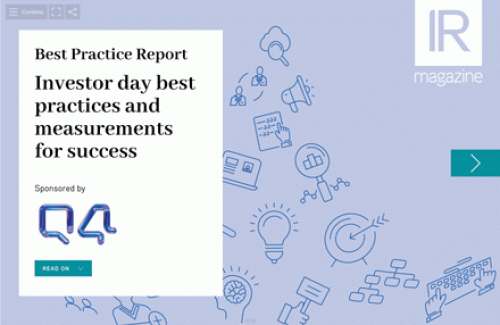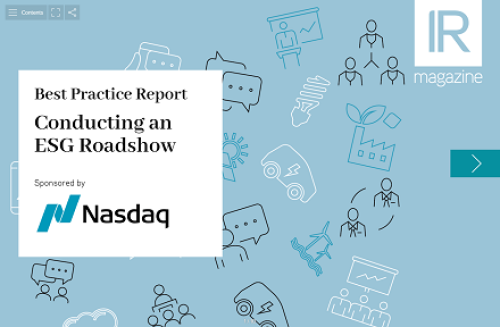The recent results of what was formerly known as Extel’s UK Small & Mid-cap Survey, now published under the Institutional Investor brand, highlight how few firms make it to the top spots. While this year’s survey is split across three categories – research, sales and corporate access – just three companies dominate the top spots: Peel Hunt, Numis and Investec.
Andrew Peck, head of Investec’s listed client group, provides investment advice to institutional investors and advises listed companies on their relationships with public markets. Here, he talks candidly with IR Magazine about what makes Investec stand out, how corporate access has changed under Covid-19, what smaller companies can do to attract attention – and what he considers good IR.
Investec ranks second in the Institutional Investor broker survey for corporate access (as well as second for sales and third for research). What do you think it is that makes you stand out?
I think the first thing that makes a broker stand out for corporate access is the quality of the client base: investors want access to high-quality businesses. We look after about 100 corporate clients and I would argue that relative to most other brokers, they are an outstanding set of businesses. That’s the starting point. After that, it’s about consistency: investors want regular access and rapid access.
Investors are, of course, naturally cautious about new companies. When you’re making substantial equity investments, risk is very high on the list of things you’re concerned about. But our track record of having consistently helped investors make money and, critically, having high-quality companies that deliver on their promises and have relatively infrequent disappointments are what matters. It’s that combination of confidence and consistent access that makes a difference.
I don’t think there’s any real magic about it; it’s just about doing the basics properly. If you have investors saying they’d like to speak to one of your companies, it’s doing that quickly. Then, where you think your corporate has an interesting story or interesting thing to say at the moment, it’s also about getting out there and aggressively promoting it.
How has your approach changed for a post-Covid-19 world?
The most obvious thing that’s changed is that, historically, all brokers – and we were no different – would typically go through this process of providing access by trekking around the city with companies on formal roadshows or one-off meetings. And clearly that ceased instantaneously [when the pandemic hit].
I think what surprised everyone is how efficient it has been to provide access through video calls. If you’re looking at a company from an investment perspective, the body language of the management team members and the kind of personal-level interactions you have are remarkably important parts of understanding what makes them tick – what makes the company tick. And you get that far more over a video call than you do over a phone call.
If you spoke to institutional investors now, they would largely tell you they have also been amazed at how efficient the process is. Investors can do much more in the day and companies are not having to taxi and tube around the city to see them.
[Video] is extremely efficient for meetings where you already know the management team or the company and you’re getting updates, or where your knowledge is being added to. Where it’s much more difficult is when it’s the first time you’re meeting the company. With something like an IPO, for example, investors would probably still want that face-to-face contact – and a slightly longer meeting: IPOs are a higher-risk investment as the company has no public markets track record.
Once we’re back to some degree of normality, I think we’ll see some sort of blended model and, if it’s a company you’ve not met in the past, then a face-to-face meeting would add something video couldn’t. I think that will be quite a powerful model, where you meet face to face for first meetings and the rest will be video calls – and hence much more efficient.
Have you seen companies getting creative with corporate access as a result of the pandemic, or has it been more about sticking to the trusted basics?
This concept of the fireside chat has kicked in. It has become very popular to get a management team and organize a large group video call, which is moderated typically by the broker. It’s not a formal results presentation so companies don’t typically run through detailed numbers slides: [instead] it’s a pretty informal Q&A session, talking about what’s going on in the markets, how the business is doing.
That’s been an innovation, and investors seem to love it. We’ve been getting audiences of 30-40 investors or more on each call for relatively small companies – in some cases where you might normally find it quite difficult to organize a results roadshow with lots of meetings. But for this one-hour fireside chat, everyone dials in and listens in.
You definitely wouldn’t have got 30-plus investors on a fireside chat before. I guess if you’re a cynic, you might say, ‘Well, the markets are so dynamic with the virus affecting how supply chains are changing and how customer behavior is changing, so people are particularly interested in finding out what’s going on in real time and outside of formal reporting periods’. Given they’ve become an established way of providing corporate access and communicating with investors, however, I think [the fireside chat] will endure to some degree.
Do you think the pandemic has impacted how research is viewed and consumed?
I think research was changing anyway as a consequence of Mifid II and that’s what has had the more dominant effect.
I noticed, however, that our research analysts became very productive in the early stages of the lockdown, probably just because the amount of noise they were dealing with on a daily basis went down and they had more time to really focus on producing good research – which they did.
But the main change was already happening: as a consequence of Mifid II, institutional investors have been cutting back their research budgets. I think those cuts have probably stabilized now, but they’ve involved really restricting payments to some of the less significant brokers, if you like.
Increasingly, if you look at the small-cap market, my suspicion is [that investors are] consuming less research [from smaller brokers] and they’re consuming more research from the big three. That’s consistent with what investors are telling us anecdotally, which is that they are polarizing their research budget [to focus] on a small number of what are – in their view – bigger and better houses.
I think that was always going to be an inevitable consequence of Mifid II. By moving the burden of research payments from the fund to the fund manager and, in effect, squeezing the fund managers’ margin, there was always going to be pressure to cut research costs. The inevitable result of that would be a focus on a smaller number of brokers that fund managers felt provided the research they were looking for. I think that’s what you’re seeing – and I think that will continue.
There’s a general view out there that the volume of small-cap coverage is falling. I don’t think it’s fully played out yet. But the economics of the market for small caps certainly have changed a lot.
What are your thoughts on the proposed Mifid II rollback?
I don’t actually think it would make much difference to the current research market for small and mid-caps. If you look at it from an institutional investor point of view, I can’t see how an institution – having taken that cost away from its funds – could reverse that. If you were an institutional investor, you would not want to go back to your own asset providers and say, ‘We were paying for the research, but they’ve rolled back the Mifid rule so we’re going to load it back onto the fund as a dealing cost’. That would be a very, very short conversation.
So it will remain on the fund managers’ P&L and, as a consequence, I don’t think there will be any increase in research spending – regardless of any change to the Mifid II rules. In theory, you could see an increase in the consumption of free research by institutions but I would question why any brokers would start to produce that research if there was no prospect of being paid for it.
The other argument is that it’s been enormously disruptive and expensive to transition from the old system to the new Mifid II system. I don’t think anyone’s going to have the heart to transition back again.
What could smaller companies do to try to build coverage or make themselves more attractive?
If you look at it from a fairly hard-nosed perspective, initiating research on a company is a pretty expensive activity. You’re talking about a good chunk of time for an analyst to build models, produce the copy and then maintain that research over time. It would depend on the company but it typically costs tens of thousands of pounds, if not more, a year to initiate research on a company, so you’d have to look at that and say, ‘What’s the return on that investment?’ If it’s a very small company, then what’s the business case?
That’s the fundamental issue. And that’s the impact Mifid II has had: everyone is taking an individual business case view of initiating [research] on small companies. [Where analysts] are initiating on smaller companies, [I think it’s] because they see opportunities to work with the company as the broker or an adviser. But purely publishing research and hoping the institutions will pay us for it? That’s quite a hard business case to build.
So from the company’s point of view, that’s a difficult conundrum. One thing I would say, however, is that if you are a small company and you are choosing your house broker (or, in some cases, joint brokers), you need to be pretty comfortable that you’ve chosen one that produces research that is actually being read. Individual brokers can give you readership stats or you can look at Extel votes, for example.
Once you get outside the top three or four analysts in a sector, I suspect the research readership probably falls very, very fast. Taking my Investec hat off for a moment, if a chief executive or a chairman came to me and asked, ‘How do I make sure my story is out there?’, I would simply say that you need a top-ranked analyst covering you, backed by a proactive sales team. Putting my Investec hat back on again, of course I’d explain that Investec provides precisely that!
Finally, what does good investor relations look like to you?
Overall, the most critical thing in any investor relations strategy is: under-promise and over-deliver. It’s remarkable how many companies struggle to get that side of investor communications right but it is the number one thing that gets you highly rated as a company and well regarded by investors.
Investors also love direct communication: they want you to tell it like it is. And again, it’s remarkable how often companies are nervous about just telling investors what’s going on in their business and what’s going on in their markets. Trying to gild the lily – to the extent that, at some point, if things aren’t going that well, you will have to de-gild it –will always create a long-term drag on valuation.
Beyond that, more practically, it’s just consistent, open communication. And when I say consistent, I mean trekking around on corporate roadshows. You often have to see companies three or four times before they’ll finally make a decision and buy some shares, and for management teams that can be quite a tough process. But [like successful corporate access] it’s about having a consistent, steady approach.










